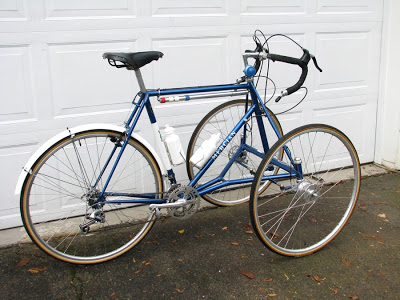
Karls Trike conversion Measurements:
58cm Seat Tube (center to center) or 23.5 inches center to top.56cm Top Tube (center to center).
Specifications:
SERIAL NUMBER: #6893
SADDLE: Brooks B17 Black leather saddle.
SEAT POST: Campagnolo.
HANDLEBAR STEM: Technomic.
HANDLEBARS: ITM, 44cm wide c/c.
HEADSET: Stronglight.
BRAKE LEVERS: Mafac.
BRAKE CALIPERS: Shimano Deore LX cantilever rear wheel.
GEAR SHIFT MECHANISM: Suntour Bar-con, bar end shifters.
REAR HUB: Campagnolo Record High Flange.
FRONT HUBS: Sachs High Flange Drum.
WHEELS:
RIMS: Mavic MA3 with DT spokes.
TIRES: Panaracer Pasela 700 x 28.
FENDERS: Bluemels Club.
CRANKSET: Stronglight 100LX 65mm. 46/36/30
BOTTOM BRACKET: Stronglight.
PEDALS: No pedals.
PUMP: Bluemels.
I have complete documentation of both the purchase of the Mercian frame and the conversion done by Roman Roads in Wales, UK. Documents include a handbook and all receipts. In all, it records the complete provenance.
Roman Road Cycles, the maker of the Newton Tricycle, prices their mid-range trike at £1750 and the unpainted, uninstalled conversion kit goes for £950. These prices do not include shipping to the US. These kits or and complete trikes are rare here in the States. I have owned a conventional Longstaff racing trike and by comparison, I prefer the Newton conversion with Ackermann steering.
Here is the description of the Newton tricycle conversion kit taken from the Roman Road Cycles website: http://www.roman-road.co.uk/
"Purchasing a new C212 from Roman Road Cycles in Wales, the cost begins at UK£1750 for a good but not too expensive setup, using mostly mid-range equipment. We don't see the point in having a custom-built frame and fitting cheap parts to it! Specifying a top-of-the-range groupset together with, for example, Hope or Magura disc brakes can easily add another UK£1000 to the price.
During the last 100 or so years there have been some tricycles produced with two wheels at the front; their lack of success probably owes more to the development of a suitable differential axle and to poorly designed steering than to anything else. The Newton conversion uses an Ackermann-type steering, just like a car, and, while steering and riding any trike takes a little time to get used to, the steering of the Newton is extremely good and the handling is better than most "conventional" trikes.
There are three main advantages in the "2-front-wheels" layout - firstly, the drive is applied to the centre-line of the machine, which is not the case with many cheaper conventional trikes using single-wheel drive, additionally, any conventional cycle transmission can be used. The second advantage is in weight distribution, firstly the weight on the driving wheel is increased, giving better traction, and secondly weight transfer when cornering is much easier - if the inside wheel starts to lift on a corner, you simply lean your weight onto the inside handlebar. A related issue is that if the machine lifts a wheel, it tilts diagonally towards the rear, whereas a conventional trike tilts towards the front - since generally you are going forwards, your momentum makes the conventional machine more likely to overturn. Finally, the braking is far superior, now using Avid mechanical disc brakes as standard on both front wheels, giving much greater safety - by contrast, many cheaper "conventional" trikes only brake one of their back wheels, some even have 2 brakes fitted to the front wheel and none on the rear!
The main tubes of the conversion are Reynolds 525, bronze welded. The conversion is designed to fit a standard frame 21" (53cm) or over in size, and using wheels in the range from 24" to 27", including ATB sizes. It fits onto the bicycle by removing the complete front fork assembly and attaches by means of a clamp at the head tube and another at the bottom bracket. The conversion set weighs around 8.7 Kg, whereas a typical front fork, wheel and brake assembly weighs around 3 Kg, so the increase in weight over a standard bike is about 5∏ Kg or 12 lbs. The front wheel track is about 27" (68cm), and the overall width is about 33" (84cm) when travelling in a straight line. The complete machine can be got through a doorway as narrow as 29" (74cm) by turning the front wheels. For this conversion, which is also available for aluminium frames, we prefer to have the frame here to ensure a good fit. We can also offer a permanent conversion welded on to your bike frame, which is neater, stronger and slightly lighter - of course, to do this, we have to have the cycle frame here."